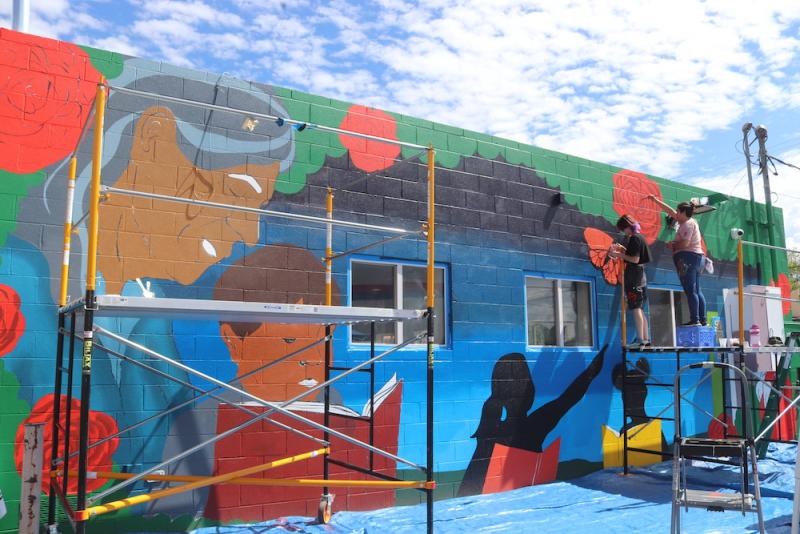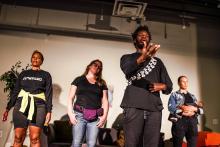ARP Grant Spotlight: Working Classroom (Albuquerque, NM)

Jardin de Historias Mural project, Summer 2022. Lead Artist: Michelle Pérez Fuentes. Photo courtesy of Working Classroom, 2022
In 1987, Nan Elsasser, returning to Albuquerque, New Mexico, from a trip to Nicaragua shared stories of the Nicaraguan youth she had met—in addition to living with fear, hunger, insecurity and violence, the children attended schools with no books, no pencils, and no paper. Her audience at home, middle school students with few resources themselves, wanted to give back. After deliberation, the group decided to write books for the youth in Nicaragua, and the foundation of Working Classroom was laid.
For three years, students and the professor met twice weekly at a local community center to write and illustrate books. By the time the project, called “Books for Bluefields,” ended, they had delivered over 5,000 copies of 32 original books to primary schools in and around Bluefields, a small town on the Atlantic coast of Nicaragua. Now known as Working Classroom, the project has continued supporting youth as agents of change through arts projects or programs that emphasize community advocacy, academic excellence, artistic creativity, and life skills within the Albuquerque community.
At Working Classroom in Albuquerque, New Mexico, youth from 12-21 participate in workshops taught by contemporary artists and learn how to use artistic expression as a tool to resist systemic injustice and demand a more equitable society. The students participate in visual arts, media arts, public arts, and theater arts workshops to build their technical skills and hone creative expression. Together with intergenerational teaching artists and other collaborators, Working Classroom creates a space for voices of under resourced communities and BIPOC artists within a predominantly white art world.
The logistical and practical challenges of an ongoing pandemic have inspired Working Classroom to experiment with its program format as the world adapts to coexisting with COVID-19. Executive Director Madalena Salazar notes that during the pandemic Working Classroom lost its ability to host a physical community space and that encouraged the organization to offer online programming and an emphasis on artist and youth mentorship.
“We've gone through this incredible social shift between the pandemic and the racial justice movement that we've seen over the past several years. It’s impactful to all of us in our organization because we all live it, we all are part of it. We are all within that movement, and it’s forced us to ask ‘who are we now?’” Salazar said.
Working Classroom received an American Rescue Plan grant earlier this year, which allowed the organization to re-invest in itself and its staff. After experiencing staff transitions early in the pandemic and recognizing burnout among her team, Salazar said the ARP grant allowed her to raise salaries and benefits for the staff.
“This isn't about ego or earning a lot of money. This is about the good that we're doing for others and a lot of folks recognizing how toxic that can become and how burnout inducing that can be. When people leave Working Classroom, whether they are our volunteers, our artists, our staff, I want it to be because they have grown or are inspired and are moving to something else amazing.”
One of the most public displays of Working Classroom’s work are the murals that color the facades of buildings across downtown Albuquerque. Recently, Working Classroom partnered with artist Nani Chacon and the University of New Mexico’s Department of Computer Science to complete an interactive mural on the campus’ building. The mural explored interweaving painting techniques with technology and the teaching artists collaborated with the students to incorporate computer programming into the interactive LED lighting design inspired by local flora and fauna.
The goal of Working Classroom is not only to teach young people how to conceptualize and work on murals but also to teach young people to listen to and better understand community perspectives. For Salazar, the process of mentoring and engaging students in service to their communities can be more significant than the projects themselves.
“Some of the students we work with don’t have a comfortable place to go home to. Projects like this can give them a sense of ownership of their identity and their community. It becomes a multilayered, community-driven project where different groups are gaining a better understanding of the history and vision of the place they are serving,” Salazar said.
After each project is completed, Working Classroom aims to reflect and honor the communities that their murals serve. The group provides the lead artist and all assistants proper compensation, and is a site of education for visitors so that they might learn something about the place and its people—that might mean a broad scope on regional history, or one person's narrative.
“Public art is a way to provide communities with a sense of ownership — not only to the art itself but to their own stories and identities,” Salazar said.





